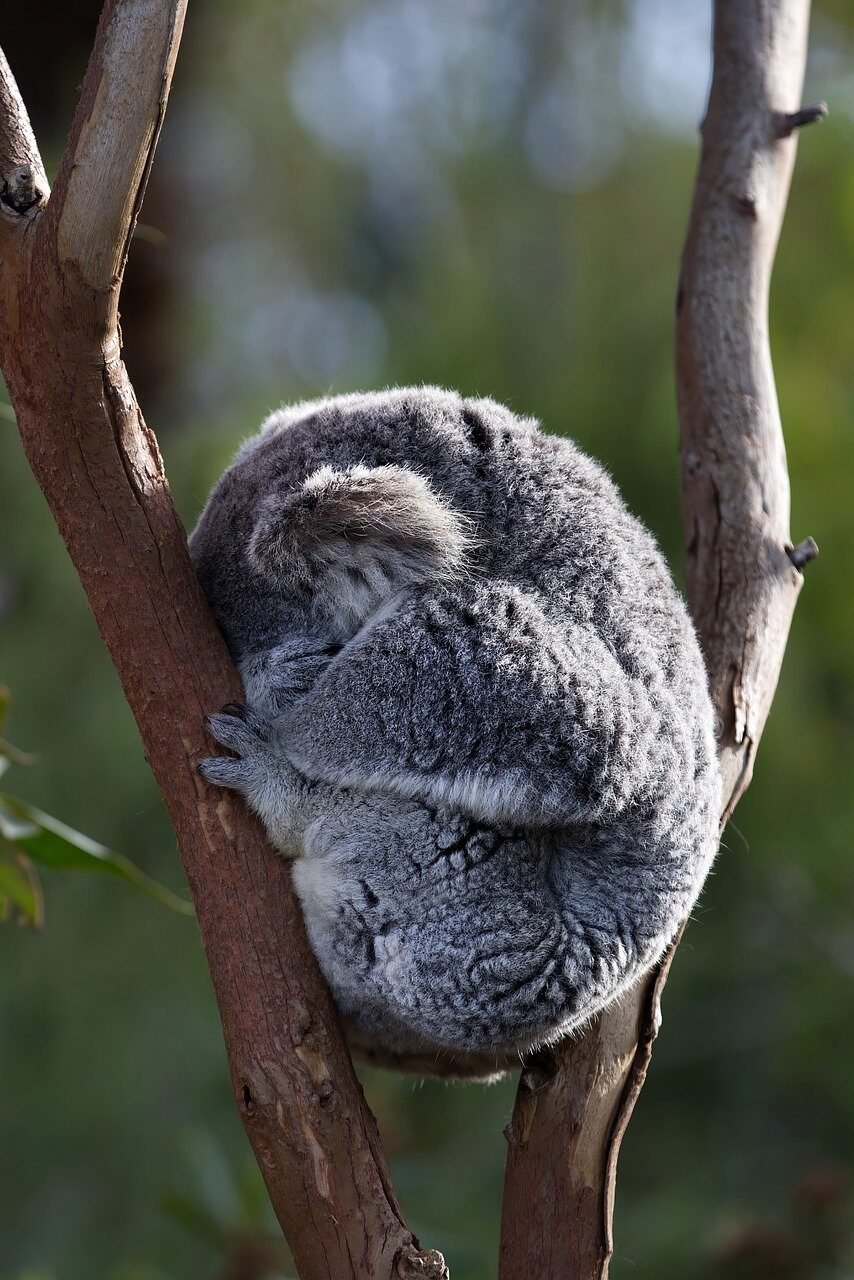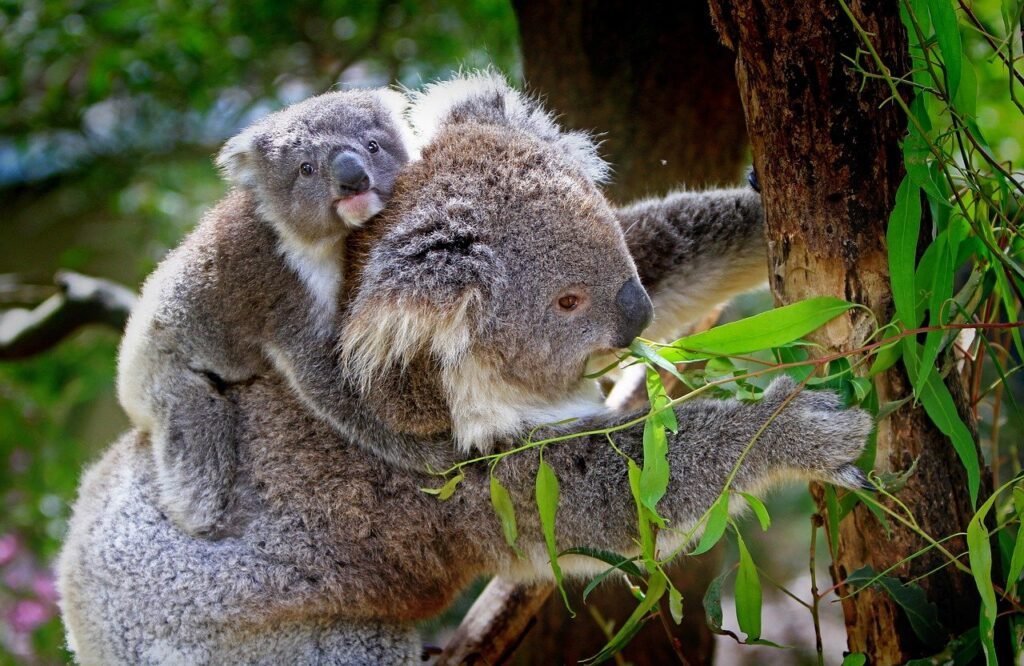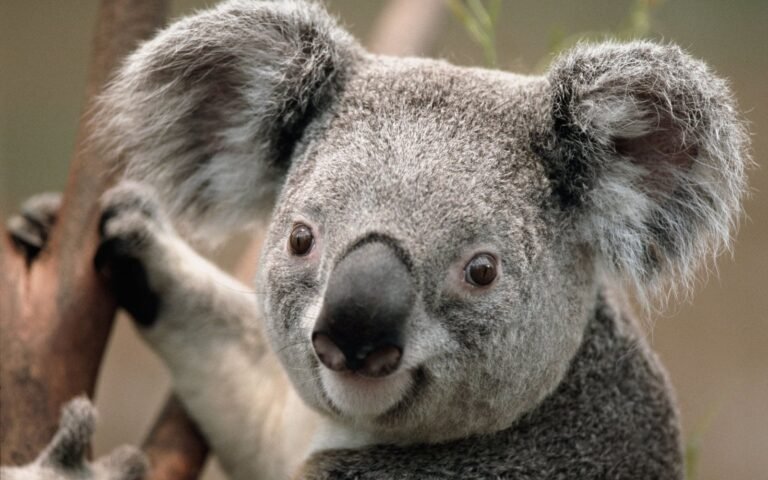Koala’s unique features, habitat and what do they eat!
Does this thought cross your mind: are Koalas dangerous? Their unique appearance and gentle demeanor endear them to people everywhere. They are native to Australia and can be found in the eucalyptus forests along the eastern coast, from Queensland to New South Wales, the ACT, and into the mountain woodlands of South Australia.
Koalas have round heads and big furry ears and a black nose. Their fur boasts a lovely greyish-brown color complemented by white patches on their chests, inner arms, ears, and bottoms. Interestingly, they have no fur on their nose or the palms of their paws. One of their unique features is Koala’s tough bottoms. Their bottoms help them to comfortably settle into tree forks for long periods of time.
Koalas rely on these lush forests for both food and shelter and feed almost exclusively on eucalyptus leaves. Interestingly, they can eat up to 500 grams of leaves per day. They use their keen sense of smell to pick out the freshest leaves.
How long do Koalas sleep and why it’s important?

Koalas can sleep up to 20 hours a day, engaging in their most important activity for survival. It is because of the diet they consume. The diet is immensely low in nutrients and requires a significant amount of energy to break down toxic leaves. As a result, they need to spend an incredible amount of time resting.
Spotting the Differences Male vs Female Koalas
Adult male koalas are noticeably larger than adult female koalas, with a broader face and a big black nose, making them easy to identify. They identify themselves by using their chest scent glands. On the other hand, adult female koalas have a clean chest and a backward-facing pouch for carrying their babies. This pouch helps protect their little ones from sustaining injuries as they move between trees.
Koala’s journey from Joey to Adorable Adult
Koala babies are called joeys. A newborn joey resembles a tiny jellybean! These joeys are born without fur, with closed eyes and undeveloped ears. They only rely on their mum’s warmth and care as they grow. It’s an adorable and truly magical transformation from this delicate start to the full-fledged koalas we all know and love.

Koalas unique reproductive cycle
Koalas have a very unique reproductive cycle compared to other species. They typically start breeding at two to four years of age. Male koalas usually become sexually mature at the age of 3 to 4 years, while females reach sexual maturity relatively quicker than males, around 2 to 3 years of age. The female koala can produce one joey annually until she reaches the age of 10 years.
During the breeding season, which occurs between the months of August and February, male koalas increase their vocalization and emit low-pitched bellows. They also make use of scent glands on their chests to attract female koalas.
Koalas experience a gestation period that lasts approximately 35 days. During this period, the embryo rapidly develops. Newborn koalas immediately enter their mother’s pouch and attach to a nipple. This is the very initial phase of the joey’s crucial development. A koala joey stays in its mother’s pouch for up to six months before hitching a ride on her back to begin exploring on its own. By 12 months, the joey becomes independent.
Koalas involved in dangerous activities: Navigating the Treetops with Blurry Vision
Koalas have poor vision and rely heavily on their other senses. They have excellent hearing, which helps them detect predators and other koalas. They also have an acute sense of smell, which helps them detect other koalas and their favorite food trees. The male uses a scent gland on his chest to mark trees and attract females by rubbing his chest up and down the trunk. The gland oozes a clear, oily, strong musky-smelling liquid.
Are Koalas dangerous?
Koalas are not dangerous. While they can be shy and docile, they may bite or scratch if they feel threatened or concerned, particularly during breeding season and when they become more aggressive. Altogether, they are not a threat to humans and are more known for their gentle nature.
Are Koalas Dangerous or Endangered Species
In February 2022, the status of the koala was changed from vulnerable to endangered in the states of Queensland, New South Wales, and also in the Australian Capital Territory.
Historically, they were heavily hunted for their fur, which led to significant population declines in the 1900s. Although they’re no longer hunted, koalas now face an increasing number of threats, including deforestation for agricultural and urban developments, bush fires, the spread of the deadly chlamydia disease, traffic strikes, and dog attacks. The future of this beloved animal depends on our urgent action to safeguard them and their forest homes.
Key Takeaways from This Blog Post
- Koalas sleep up to 20 hours a day to conserve energy due to their low-nutrient diet and the energy required to digest toxic eucalyptus leaves.
- Males are larger, with broader faces and distinctive scent glands on their chests, while females have a backward-facing pouch to protect their joeys.
- Koalas breed between August and February. Males mature at 3-4 years, females at 2-3 years, and a female can produce one joey annually until 10 years old.
- After a 35-day gestation, joeys stay in their mother’s pouch for up to 6 months and ride on her back until they are independent by 12 months.
- Koalas are not dangerous, though they may scratch or bite if threatened, particularly during breeding season. They are generally gentle and non-aggressive.
- Koalas are highly vulnerable to chlamydiosis, a bacterial disease, and are also impacted by habitat loss due to deforestation and climate change, contributing to their declining population.
Chlamydia – a hidden crisis dangerous for Koalas
Chlamydiosis is a widespread and significant bacterial disease affecting both wild and captive koalas across their entire range. Koalas are particularly vulnerable to chlamydiosis due to their compromised immune systems and habitat stressors such as deforestation and climate change. The disease can spread through direct contact, contributing to declining numbers of koalas’ population.
“Today, the cuddly Koalas face increase threat to their habitat than ever making them one of our most beloved yet endangered species. Reminding everyone of the urgent need to protect these little bears before they fade away from our planet forever.”


